Book Review: Hutch, Hard Work and Belief: The Tommy Hutchison Story with Kevin Shannon
 Old school.
Old school.
If it is not tattooed on the inside of his eyelids, I have a heavy fancy it shall be on his gravestone.
Tommy Hutchison is old school. Given the subtitle of his book – Hard Work and Belief – it could be very little else. This is a biography grown out of love and that drips from every syllable on the pages. It has heart and it has soul. And the fact that in a modern world, we can often dismiss the values and views of those who have lived a life is dispelled in the final few chapters as former Scottish international and current Coventry City legend Hutchison, is shown to be a guy who wants to give back to the community in a way that many who are “old school” are believed to be incapable.
Starting from the Raws in Fife where his hard-working family brought Tommy up, this is exactly the type of rags to fame story which Scottish football does so well – the big three Shankly, Busby and Stein come to mind. But it is a lot more than that. The surprise, by the end of the book, is that this has not been ghost written by a journalist but by a fan. It’s what might be described as a vanity project but the one quality missing from the entire enterprise is vanity.
Of course, this means that much of the narrative is unchallenged, that it lacks some of the critical poise that a seasoned journalist may bring and there is a lack, at times, of the perspective of others when facts are presented as fact, but it is a tremendous read. That lack of context can be difficult as you are reading through a story which is not anchored in the events of its time. You can forget what else was happening in the world and without a journalistic attention to the detail much can be left unchallenged, however, this is a modest subject matter not given to hyperbole or boastfulness; they would never allow him away with oany o that in Dundonald efter aw.
And so, we begin in Fife, a kingdom not without its troubles but it certainly had quite a few hearts – though none of them lost to any in Midlothian. In the beauty of Dundonald a boy was born who was rubbish at football at school. That he became a Scottish international is one for the cliché comics but for us it is a revelation Hutchison uses in his teaching of other kids like himself as much as to show us all what such hard work and belief can bring. It was christened in the actions of his upbringing where the chimney sweep gets an honourable mention as much as does his father and mother. This is a boy who was gratefully raised by a village and of course we have the there was no… crime, anti-social behaviour etc tropes of the past and we were poor, but it was idyllic, until you read of his father’s troubles as a miner. His illness led to poverty and yes it was different then, but poverty is poverty. Hutchison may have struggled with the cost of a boot, but he never had his heart taken from him by a lack of support.
That schooling was not to be his master is a common enough theme for those whose intelligence is to be found at the end of your legs, but Hutchison does not forswear the needs of education. He trained and became a painter and decorator out of necessity – football was not a full time occupation for someone who started in the Juniors – and from the Bluebells, he went on an odyssey which is rich in experience and full of anecdotes. It is a rich tapestry which includes the “luck” of broken legs with the Wasps, the vagaries of managerial change at the seaside, the joys of promotion – premature or otherwise, the despair of relegation, working with legendary figures of the game like Bob Stokoe, a fairly unique barter system of ticket trading to make ends meet, and all of this, before he entered the field of play in a Scotland shirt.
Of course, there are many characters named along the way including one John Burridge who must have been very young when he appeared in Hutch’s career, as he appeared in a charity game in Edinburgh in the latter part of 2022 in his seventies!
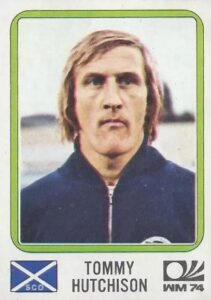 Hutch’s transfer to Coventry City and elevation to the First Division meant he was in the shop window for the Scottish selectors. That is when I, as a young spectator became aware of him – the 1974 World Cup. It was the first World Cup of which I was aware. Scotland’s manager, Willie Ormond has always been cast as the gentile figure, not seen by many as a giant of the Scottish game despite being the only Scottish manager to get us to a World Cup and come home unbeaten – although still, by Tommy Docherty’s standards, home before the postcards. I read these chapters with great interest. The names around Hutch’s debut are legends themselves, McGrain, Dalglish, Jordan, Hay, the Lawman… But it is the detail both of the campaign to get to the World Cup and whilst they were there that was of huge interest. Penny pinching blazers who put an international squad up in a halls of residence for a World Cup final friendly, cockeyed commercial deals, a wholly forgettable World Cup song, and being unable to deal with recalcitrant rowers as well as one man who saw his stature greater than his height – Billy Bremner – are all included, and I devoured them with eyes wide open.
Hutch’s transfer to Coventry City and elevation to the First Division meant he was in the shop window for the Scottish selectors. That is when I, as a young spectator became aware of him – the 1974 World Cup. It was the first World Cup of which I was aware. Scotland’s manager, Willie Ormond has always been cast as the gentile figure, not seen by many as a giant of the Scottish game despite being the only Scottish manager to get us to a World Cup and come home unbeaten – although still, by Tommy Docherty’s standards, home before the postcards. I read these chapters with great interest. The names around Hutch’s debut are legends themselves, McGrain, Dalglish, Jordan, Hay, the Lawman… But it is the detail both of the campaign to get to the World Cup and whilst they were there that was of huge interest. Penny pinching blazers who put an international squad up in a halls of residence for a World Cup final friendly, cockeyed commercial deals, a wholly forgettable World Cup song, and being unable to deal with recalcitrant rowers as well as one man who saw his stature greater than his height – Billy Bremner – are all included, and I devoured them with eyes wide open.
Of revelations, there were none, but confirmations aplenty with an earnestness, a pride for wearing a jersey that meant so much to him and his wee boy self, which must have hurt when at the tender age of only 28, he had played his last for his country.
But then Manchester City came calling… Then eventually Burnley, the flirting with management that always seemed to involve flirting in one direction, and then Wales – Swansea City, where a man once his captain now became his manager and both had to deal with a chairman seemingly out of his depth and Merthyr Tydfil.
All are given to us with great glee especially when you could make sure the carpenter gave you the keys to the drinks room…
And so, of the man whose best international goal was in a Home International defeat, who took his steer as a captain from a Welshman rather than a Scot, his spat with Jimmy Hill, rollercoaster relationship with John Bond that began with a dip, why he may never be welcomed in Sunderland, his retail acumen or lack thereof, the final where he scored twice, for each team, the times he played for Manchester United and why, his foreign odysseys in Seattle and with Bulova involved injustice in New York and a trophy for Mr. Gentleman in Hong Kong. They are told with sufficient detail of the experience and a modesty in each accomplishment.
Then came retirement from playing and possibly the most surprising part of the whole book – his role as a Football Development Officer. The way that it is told, Hutch wanted nothing to do with the professional side of the game once the boots were hung up and the managerial merry go-round was firmly shut. I was and still am an Academy Director. You get your fair share of former professionals who still believe they are the epitome of what it means to be a professional footballer and that they are still, mentally, playing each Saturday at 3pm. Here is a Football Development Officer who just happens to be a former professional footballer. Hutch approached this task with the same professional attitude which saw him turn up in shirt and tie and train in the best of facilities because that is what was deserved. Hutch took on his new role with relish – and raised his own wages whilst doing it too. There is something of the son of the Raws here which shines through.
And so why should I be surprised? Throughout the anecdotes have dwelled upon chimney sweeps with an unfortunate streak, a man covered in snuff, a sage tea lady and a family who may never have pulled on the shirt of their country but whose heart burst with pride that their son did. It is the story of a man who lived a dream and knew it. His best role, father, husband, son, prepared him for his public one and with Kevin Shannon wielding the pen he has found a muse to tell the tale and tell it well. As he was once told when down in the dumps because he thought he did not belong at a trial, he was told, “Well ye must hae something otherwise ye wouldnae be here” – aye he did indeed and now we can all share in the reading of it. Oh, the wisdom of tea ladies…
Donald C Stewart
(Publisher: Pitch Publishing Ltd. October 2022. Hardcover: 320 pages)
Buy the book here: Hutch
 Football shirt collecting seems to have grown in popularity in recent years with this reflected in the number of books recently published around the subject. These have included amongst other,
Football shirt collecting seems to have grown in popularity in recent years with this reflected in the number of books recently published around the subject. These have included amongst other, 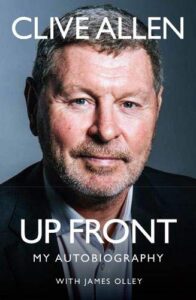 Clive Allen is one of the finest goalscorers of his generation but arguably his biggest battle has been to prove himself the best in his own family.
Clive Allen is one of the finest goalscorers of his generation but arguably his biggest battle has been to prove himself the best in his own family. Spanning the 1920s to the 2020s, this evocative collection of matchworn Manchester City shirts opens a unique window on to the club’s history that will resonate with every fan.
Spanning the 1920s to the 2020s, this evocative collection of matchworn Manchester City shirts opens a unique window on to the club’s history that will resonate with every fan. Fixture: North West Counties Football League (NWCFL) – First Division North
Fixture: North West Counties Football League (NWCFL) – First Division North The cover is an unusual but striking image featuring one of the local cotton mills in a vintage black and white look, with the club badge and match details present but not interrupting the picture of the Grade II Listed building
The cover is an unusual but striking image featuring one of the local cotton mills in a vintage black and white look, with the club badge and match details present but not interrupting the picture of the Grade II Listed building 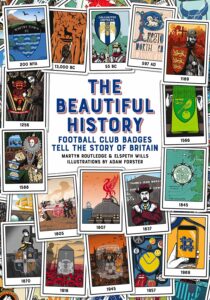 In August 2018, Pitch Publishing released
In August 2018, Pitch Publishing released  Past: As one of the most successful teams in English football, the Premier League eluded Liverpool for almost three decades, but after near-misses in 2002, 2009, 2014 and 2019, they finally put their PL duck behind them, scooping the top trophy in 2020. For a club that has had FA Cup, League Cup and Champions League success in that time, the Premier League was a long time coming, but the 2019/20 team guaranteed their place in the Reds’ long history. When it comes to past players, the Premier League roster reads like a who’s who of the best footballers in the world, so it comes as no surprise that a fair few autobiographies have followed. In fact, Liverpool are amongst the best represented when it comes to former players. Indeed, you can make a veritable XI of Liverpool Premier League autobiographies: Dudek – A Big Pole in Our Goal (which just edges out Pepe Reina’s Pepe purely on its title); Jamie Carragher – My Autobiography/The Greatest Games; Neil Ruddock – Hell Razor/The World According to Razor; Sami Hyppia – From Voikkaa to the Premiership; John Arne Riise – Running Man; Jamie Redknapp – Me, Family and the Making of A Footballer; Steven Gerrard – My Story; Gary MacAllister – Captain’s Log; Fernando Torres – El Nino; Robbie Fowler – My Life in Football; and Luis Suarez – Crossing The Line. That list excludes books by Xabi Alonso and Dirk Kuyt which are yet to be translated into English, as well as books by Bruce Grobebelaar, Jason McAteer and Michael Owen. Whilst John Barnes published his autobiography in 1999, my pick is his forthcoming book The Uncomfortable Truth About Racism.
Past: As one of the most successful teams in English football, the Premier League eluded Liverpool for almost three decades, but after near-misses in 2002, 2009, 2014 and 2019, they finally put their PL duck behind them, scooping the top trophy in 2020. For a club that has had FA Cup, League Cup and Champions League success in that time, the Premier League was a long time coming, but the 2019/20 team guaranteed their place in the Reds’ long history. When it comes to past players, the Premier League roster reads like a who’s who of the best footballers in the world, so it comes as no surprise that a fair few autobiographies have followed. In fact, Liverpool are amongst the best represented when it comes to former players. Indeed, you can make a veritable XI of Liverpool Premier League autobiographies: Dudek – A Big Pole in Our Goal (which just edges out Pepe Reina’s Pepe purely on its title); Jamie Carragher – My Autobiography/The Greatest Games; Neil Ruddock – Hell Razor/The World According to Razor; Sami Hyppia – From Voikkaa to the Premiership; John Arne Riise – Running Man; Jamie Redknapp – Me, Family and the Making of A Footballer; Steven Gerrard – My Story; Gary MacAllister – Captain’s Log; Fernando Torres – El Nino; Robbie Fowler – My Life in Football; and Luis Suarez – Crossing The Line. That list excludes books by Xabi Alonso and Dirk Kuyt which are yet to be translated into English, as well as books by Bruce Grobebelaar, Jason McAteer and Michael Owen. Whilst John Barnes published his autobiography in 1999, my pick is his forthcoming book The Uncomfortable Truth About Racism.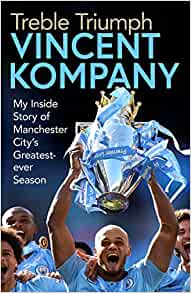 Past: If we’d been compiling this list at the start of the Premier League era, pre-Millennium, Manchester City’s story, and its players, would have looked very different indeed. Those first years of the top flight actually saw City slide all the way down to Division Two before yo-yoing back between Division One and the Premier League. It was only in 2002 that Manchester City returned to the big time, but with modest returns for a decade, until the breakthrough came in 2012 with the first Premier League title. Since then, it’s been a very different story, with Manchester City winning four of the next nine campaigns, with a lowest finish of fourth in 2016, and central to that rejuvenation has been a host of big-name incomings. Not least Sergio Aguero, who spent a decade at City and struck that famous title-winning goal, before departing in the summer and whose autobiography was published in 2014. Who could forget David Silva either – another player to give the Manchester side a decade of incredible service – for whom a tribute book was published last year. But the beating heart of the team for over a decade? None other than their captain, Vincent Kompany, a relative unknown when he arrived from Anderlecht in 2008, but who left the north-west a true City legend. So he’s the pick for City, with his 2019 book, Treble Triumph.
Past: If we’d been compiling this list at the start of the Premier League era, pre-Millennium, Manchester City’s story, and its players, would have looked very different indeed. Those first years of the top flight actually saw City slide all the way down to Division Two before yo-yoing back between Division One and the Premier League. It was only in 2002 that Manchester City returned to the big time, but with modest returns for a decade, until the breakthrough came in 2012 with the first Premier League title. Since then, it’s been a very different story, with Manchester City winning four of the next nine campaigns, with a lowest finish of fourth in 2016, and central to that rejuvenation has been a host of big-name incomings. Not least Sergio Aguero, who spent a decade at City and struck that famous title-winning goal, before departing in the summer and whose autobiography was published in 2014. Who could forget David Silva either – another player to give the Manchester side a decade of incredible service – for whom a tribute book was published last year. But the beating heart of the team for over a decade? None other than their captain, Vincent Kompany, a relative unknown when he arrived from Anderlecht in 2008, but who left the north-west a true City legend. So he’s the pick for City, with his 2019 book, Treble Triumph.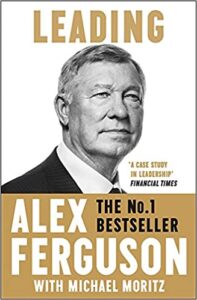 Past: Manchester United are the runaway leaders when it comes to the most Premier League titles, with thirteen. Yet despite their early domination in the nineties, their most recent trophy came nine seasons ago in 2013 – in, not at all coincidentally, Sir Alex Ferguson’s last season at Old Trafford. In recent times, the Red Devils have struggled to really put up a notable challenge for the title, though signs of recovery have been shown in the last couple of seasons under former United marksman Ole Gunnar Solksjaer. Given the size and stature of United, it’s no surprise that there are a host of autobiographies to choose from, so, as with fierce rivals Liverpool, here’s an eleven-a-side of reads. Peter Schmeichel – One (forthcoming in September); Gary Neville – Red; Jaap Stam – Head to Head; Rio Ferdinand – Thinking Out Loud (two previous autobiographies have also been published but this one reflects on the important subjects of grief and loss in Ferdinand’s life); Patrice Evra – I Love This Game (forthcoming in September); Michael Carrick – Between the Lines; Roy Keane – The Autobiography/The Second Half (surely an Extra Time is due shortly); Eric Cantona – My Notebook; Paul Scholes – My Story; Andy Cole – Fast Forward; and Dwight Yorke – The Autobiography. Notable absences are of course David Beckham, who has some five books to his name and Wayne Rooney who has his own trilogy. However, when it comes to picking one icon of Manchester United’s past it surely has to be the club’s most successful manager, Sir Alex, whose books include A Year in the Life, Managing my Life, My Autobiography and Leading.
Past: Manchester United are the runaway leaders when it comes to the most Premier League titles, with thirteen. Yet despite their early domination in the nineties, their most recent trophy came nine seasons ago in 2013 – in, not at all coincidentally, Sir Alex Ferguson’s last season at Old Trafford. In recent times, the Red Devils have struggled to really put up a notable challenge for the title, though signs of recovery have been shown in the last couple of seasons under former United marksman Ole Gunnar Solksjaer. Given the size and stature of United, it’s no surprise that there are a host of autobiographies to choose from, so, as with fierce rivals Liverpool, here’s an eleven-a-side of reads. Peter Schmeichel – One (forthcoming in September); Gary Neville – Red; Jaap Stam – Head to Head; Rio Ferdinand – Thinking Out Loud (two previous autobiographies have also been published but this one reflects on the important subjects of grief and loss in Ferdinand’s life); Patrice Evra – I Love This Game (forthcoming in September); Michael Carrick – Between the Lines; Roy Keane – The Autobiography/The Second Half (surely an Extra Time is due shortly); Eric Cantona – My Notebook; Paul Scholes – My Story; Andy Cole – Fast Forward; and Dwight Yorke – The Autobiography. Notable absences are of course David Beckham, who has some five books to his name and Wayne Rooney who has his own trilogy. However, when it comes to picking one icon of Manchester United’s past it surely has to be the club’s most successful manager, Sir Alex, whose books include A Year in the Life, Managing my Life, My Autobiography and Leading.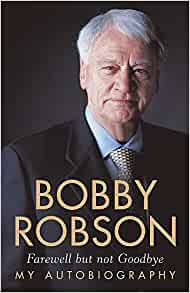 Past: Starting the Premier League era in Division 1, Newcastle were the first side to get promoted, finishing first in 1992/1993, and joining the top flight, where they stayed for some sixteen seasons. Relegation in 2009 was followed by immediate promotion in 2010 and a similar pattern ensued in 2016 when the Magpies found themselves once more in the Championship before bouncing back at the first time of asking. In their four seasons back, Newcastle have enjoyed some degree of stability but nothing quite as high-flying as their back-to-back second-placed finishes in 1996 and 1997. When it comes to former players, one name sticks out, certainly in the Premier League era – Alan Shearer, and, unsurprisingly, there’s a couple of books, with Dave Harrison, that cover the number 9’s prolific career as the League’s all-time top goalscorer, as well as the more recent My Illustrated Career. Newcastle’s other famous son, Paul Gascoigne, also has a number of books to choose from, charting successes and struggles on and off the pitch. Cult figures David Ginola and Nolberto Solano also published autobiographies, the former titled Le Magnifique and the latter Blowing My Own Trumpet, while Shay Given, who spent 12 years on Tyneside, brought out his autobiography, Any Given Sunday, in 2017. But whilst Shearer may be the player that defines Newcastle United’s Premier League history, and his statue stands in pride of place outside St James’ Park, it is joined by the manager who defined this period in the club’s recent past – Sir Bobby Robson. A couple of recent biographies by Bob Harris (Bobby Robson: The Ultimate Patriot) and Harry De Cosemo (Black & White Knight) offer new reflections on the man, but for the definitive autobiography, look no further than Farewell but Not Goodbye.
Past: Starting the Premier League era in Division 1, Newcastle were the first side to get promoted, finishing first in 1992/1993, and joining the top flight, where they stayed for some sixteen seasons. Relegation in 2009 was followed by immediate promotion in 2010 and a similar pattern ensued in 2016 when the Magpies found themselves once more in the Championship before bouncing back at the first time of asking. In their four seasons back, Newcastle have enjoyed some degree of stability but nothing quite as high-flying as their back-to-back second-placed finishes in 1996 and 1997. When it comes to former players, one name sticks out, certainly in the Premier League era – Alan Shearer, and, unsurprisingly, there’s a couple of books, with Dave Harrison, that cover the number 9’s prolific career as the League’s all-time top goalscorer, as well as the more recent My Illustrated Career. Newcastle’s other famous son, Paul Gascoigne, also has a number of books to choose from, charting successes and struggles on and off the pitch. Cult figures David Ginola and Nolberto Solano also published autobiographies, the former titled Le Magnifique and the latter Blowing My Own Trumpet, while Shay Given, who spent 12 years on Tyneside, brought out his autobiography, Any Given Sunday, in 2017. But whilst Shearer may be the player that defines Newcastle United’s Premier League history, and his statue stands in pride of place outside St James’ Park, it is joined by the manager who defined this period in the club’s recent past – Sir Bobby Robson. A couple of recent biographies by Bob Harris (Bobby Robson: The Ultimate Patriot) and Harry De Cosemo (Black & White Knight) offer new reflections on the man, but for the definitive autobiography, look no further than Farewell but Not Goodbye.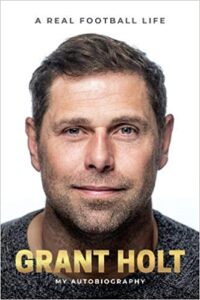 Past: No one could accuse Norwich City of not having had an eventful past, not least in the last two decades of the Premier League era, in which they’ve been relegated from the top-flight four times, relegated from the Championship once and experienced no less than six promotions. Canaries fans will surely be hoping for a smoother ride this time out back in the Premier League, following their immediate promotion last season. Fans looking for a Norwich autobiography are not overwhelmed with choice, it has to be said, but there are a few knocking around out there, including top striker in 2003/04 Darren Huckerby and former goalkeeper Bryan Gunn, whilst Iwan Roberts’ All I Want For Christmas offers an insider look at Norwich’s promotion-winning 2003/04 season, taking the campaign month by month. However, pick of the bunch goes to Grant Holt, with his autobiography A Real Football Life. Club top scorer in League One in 2009/10, the Championship in 2010/2011 and three consecutive seasons in the Premier League from 2011 to 2014, although, surely, he’s remembered just as fondly in wider circles for his foray into wrestling in 2018.
Past: No one could accuse Norwich City of not having had an eventful past, not least in the last two decades of the Premier League era, in which they’ve been relegated from the top-flight four times, relegated from the Championship once and experienced no less than six promotions. Canaries fans will surely be hoping for a smoother ride this time out back in the Premier League, following their immediate promotion last season. Fans looking for a Norwich autobiography are not overwhelmed with choice, it has to be said, but there are a few knocking around out there, including top striker in 2003/04 Darren Huckerby and former goalkeeper Bryan Gunn, whilst Iwan Roberts’ All I Want For Christmas offers an insider look at Norwich’s promotion-winning 2003/04 season, taking the campaign month by month. However, pick of the bunch goes to Grant Holt, with his autobiography A Real Football Life. Club top scorer in League One in 2009/10, the Championship in 2010/2011 and three consecutive seasons in the Premier League from 2011 to 2014, although, surely, he’s remembered just as fondly in wider circles for his foray into wrestling in 2018.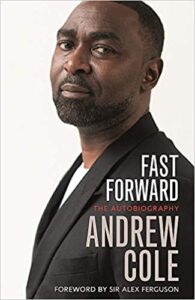 When it comes to football, there are some players who remain, either through sporting posterity or perhaps through wilful self-promotion, front and centre in fans’ consciousness and other who fade, rightly or wrongly, into the background. For many Manchester United fans, I imagine Andrew Cole is forever etched in their memories, part of the historic 1999 treble-winning squad, but for all of that success, for neutral fans he is probably not as well-remembered as other players of that generation, team-mates like Scholes, Giggs and Keane, and even his strike partner Dwight Yorke. Yet, he remains the third-highest goalscorer, behind only Alan Shearer and Wayne Rooney, in Premier League history, with 187 goals, as well as being joint-top goalscorer with 34 goals in a 42-game Premier League season, and the first player to top both the Premier League goalscoring and assists charts in the same season. Add to this, a clean sweep of trophies, including five Premier League titles, two FA Cups, two Charity Shields, a League Cup and, of course, that iconic Champions League, as well as PFA Young Player of the year.
When it comes to football, there are some players who remain, either through sporting posterity or perhaps through wilful self-promotion, front and centre in fans’ consciousness and other who fade, rightly or wrongly, into the background. For many Manchester United fans, I imagine Andrew Cole is forever etched in their memories, part of the historic 1999 treble-winning squad, but for all of that success, for neutral fans he is probably not as well-remembered as other players of that generation, team-mates like Scholes, Giggs and Keane, and even his strike partner Dwight Yorke. Yet, he remains the third-highest goalscorer, behind only Alan Shearer and Wayne Rooney, in Premier League history, with 187 goals, as well as being joint-top goalscorer with 34 goals in a 42-game Premier League season, and the first player to top both the Premier League goalscoring and assists charts in the same season. Add to this, a clean sweep of trophies, including five Premier League titles, two FA Cups, two Charity Shields, a League Cup and, of course, that iconic Champions League, as well as PFA Young Player of the year. Choosing fifty moments that define football seems generous enough on the face of it, but when it comes down to a sport that has been in existence for over 150 years, things aren’t quite so clear-cut. So, hats off to Ben Jones and Gareth Thomas – writers of
Choosing fifty moments that define football seems generous enough on the face of it, but when it comes down to a sport that has been in existence for over 150 years, things aren’t quite so clear-cut. So, hats off to Ben Jones and Gareth Thomas – writers of  For those young ‘uns brought up on the misleading title ‘Champions’ League’, it might come as a surprise to learn that the European Cup Winners’ Cup actually was a cup competition between European teams who had won their own domestic cup finals, not just another chance for the top clubs to keep on playing each other and guarantee income streams.
For those young ‘uns brought up on the misleading title ‘Champions’ League’, it might come as a surprise to learn that the European Cup Winners’ Cup actually was a cup competition between European teams who had won their own domestic cup finals, not just another chance for the top clubs to keep on playing each other and guarantee income streams.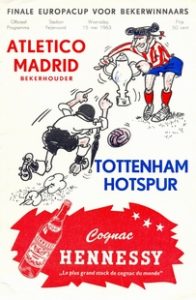 The most memorable of the early finals was Tottenham’s 5-1 thumping in 1963 of Atletico Madrid, winners the previous year. Two of the goals for Spurs were scored by the peerless Jimmy Greaves whose injury in the World Cup group stages probably cost him his place in the Final. No substitutes in those days, so a suited Greaves had to watch England’s historic win from the bench as a supporter. Spurs were the first British winners in Europe, and it was a fitting reward, and swansong, for a team who had done the domestic ‘double’ in 1961 – the first time by any club in 64 years.
The most memorable of the early finals was Tottenham’s 5-1 thumping in 1963 of Atletico Madrid, winners the previous year. Two of the goals for Spurs were scored by the peerless Jimmy Greaves whose injury in the World Cup group stages probably cost him his place in the Final. No substitutes in those days, so a suited Greaves had to watch England’s historic win from the bench as a supporter. Spurs were the first British winners in Europe, and it was a fitting reward, and swansong, for a team who had done the domestic ‘double’ in 1961 – the first time by any club in 64 years. The last match with strong links to the World Cup Final was, understandably enough, the Final in May 1966 where Liverpool lost 2-1 after extra time to Borussia Dortmund, a kind of England v West Germany rehearsal. Kind of. Roger Hunt would go on two months later to turn the tables on the three Dortmund players selected for their nation in the Final; Tilkowski, Emmerich and Held. Hunt is famous for doing absolutely nothing in the World Cup Final except turn away to celebrate Hurst’s ‘was it over the line’ goal.
The last match with strong links to the World Cup Final was, understandably enough, the Final in May 1966 where Liverpool lost 2-1 after extra time to Borussia Dortmund, a kind of England v West Germany rehearsal. Kind of. Roger Hunt would go on two months later to turn the tables on the three Dortmund players selected for their nation in the Final; Tilkowski, Emmerich and Held. Hunt is famous for doing absolutely nothing in the World Cup Final except turn away to celebrate Hurst’s ‘was it over the line’ goal.